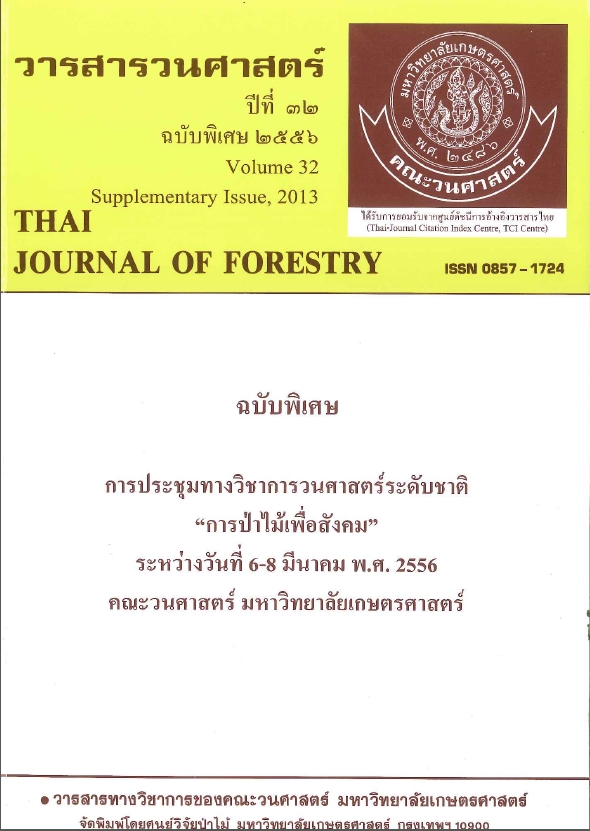การศึกษาโครงสร้างสังคมพืชป่าบุ่งป่าทาม ในลุ่มน้ำมูล
Main Article Content
บทคัดย่อ
การศึกษาโครงสร้างสังคมพืชป่าบุ่งป่าทาม ในลุ่มน้ำมูล มีวัตถุประสงค์เพื่อ 1) ศึกษาลักษณะโครงสร้างสังคมพืช องค์ประกอบของชนิด ความหนาแน่น ความเด่น ความคล้ายคลึงระหว่างสังคมและความหลากหลายของชนิด 2) ศึกษาความสัมพันธ์ระหว่างสังคมพืชกับปัจจัยแวดล้อมบางประการ ทำการศึกษาในช่วงเดือนตุลาคม พ.ศ. 2554 ถึงเดือนกันยายน พ.ศ. 2555 ทำการเก็บข้อมูลของสังคมพืชจำนวน 9 หมู่ไม้ โดยแต่ละหมู่ไม้วางแปลงตัวอย่างชั่วคราวขนาด 30 x 30 เมตร จำนวน 3 แปลง ต่อ 1 หมู่ไม้ วิเคราะห์การจัดกลุ่มสังคมพืชป่าบุ่งป่าทามด้วยเทคนิค Cluster Analysis โดยวิธี Relative Sorensen Distance และ Ward’s Linkage Methods และวิเคราะห์การจัดลำดับ (Ordination) ของสังคมพืชกับปัจจัยแวดล้อม โดยวิธี Canonical Correspondence Analysis (CCA)
ผลการศึกษาพบต้นไม้ทั้งหมดจำนวน 6,009 ต้น (2,473 ต้นต่อเฮกแตร์) มีพรรณไม้ทั้งหมด 85 วงศ์ 272 สกุล 398 ชนิด วงศ์ที่มีค่าดัชนีความสำคัญสูงสุด 3 อันดับแรก เรียงจากมากไปหาน้อย ได้แก่ วงศ์ฉนวน (Fabaceae) วงศ์แฟบน้ำ (Phyllanthaceae) และวงศ์เหียง (Dipterocarpaceae) ตามลำดับ สามารถจัดกลุ่ม ได้เป็น 4 สังคมย่อย คือ สังคมตะแบกนา (Lagerstroemia floribunda type, LAGF) สังคมเหียง (Dipterocarpus obtusifolius type, DIPO) สังคมฝ่ายน้ำ (Mallotus thorelii type, MALT) และสังคมข่อย (Streblus asper type, STRA) พบว่าสังคมข่อย มักพบบริเวณตอนบนของลุ่มน้ำมูล ดินมีค่า pH สูง ช่วงระยะเวลาของน้ำท่วมขังน้อย (7-15 วัน) ส่วนสังคมตะแบกนา สังคมฝ่ายน้ำ และสังคมเหียง พบบริเวณตอนกลางและตอนล่างของลุ่มน้ำมูล ดินเป็นตะกอนดินเหนียว ดินในสังคมฝ่ายน้ำมีปริมาณอินทรียวัตถุสูงเนื่องจากเป็นที่ลุ่มมีน้ำขังและมีการท่วมขังของน้ำยาวนาน (45-60 วัน) ลักษณะโครงสร้างทางด้านตั้งของสังคมพืชป่าบุ่งป่าทาม สามารถแบ่งออกได้ 3 ชั้นเรือนยอด ได้แก่ เรือนยอดชั้นบน เรือนยอดชั้นรอง และชั้นไม้พื้นล่าง สำหรับค่าดัชนีความหลากชนิด (Shannon-Wiener’s index) พบว่าสังคมตะแบกนา มีค่า 4.07 และสังคมฝ่ายน้ำมีค่า 2.16 ส่วนสังคมตะแบกนาและสังคมเหียงมีความคล้ายคลึงกันมากที่สุดเท่ากับร้อยละ 32.75 โดยที่สังคมเหียงและสังคมข่อยมีความคล้ายคลึงกันน้อยที่สุดเท่ากับร้อยละ 12.33
คำสำคัญ: โครงสร้างสังคมพืช ช่วงระยะเวลาในการท่วมขังของน้ำ ป่าบุ่งป่าทาม พื้นที่ชุ่มน้ำ ลุ่มน้ำมูล
Downloads
Article Details

อนุญาตภายใต้เงื่อนไข Creative Commons Attribution-NonCommercial-NoDerivatives 4.0 International License.
ข้าพเจ้าและผู้เขียนร่วม (ถ้ามี) ขอรับรองว่า ต้นฉบับที่เสนอมานี้ยังไม่เคยได้รับการตีพิมพ์และไม่ได้อยู่ในระหว่างกระบวนการพิจารณาตีพิมพ์ลงในวารสารหรือสิ่งตีพิมพ์อื่นใด ข้าพเจ้าและผู้เขียนร่วม (ถ้ามี) ยอมรับหลักเกณฑ์และเงื่อนไขการพิจารณาต้นฉบับ ทั้งยินยอมให้กองบรรณาธิการมีสิทธิ์พิจารณาและตรวจแก้ต้นฉบับได้ตามที่เห็นสมควร พร้อมนี้ขอมอบลิขสิทธิ์ผลงานที่ได้รับการตีพิมพ์ให้แก่วารสารวนศาสตร์ คณะวนศาสตร์ มหาวิทยาลัยเกษตรศาสตร์ กรณีมีการฟ้องร้องเรื่องการละเมิดลิขสิทธิ์เกี่ยวกับภาพ กราฟ ข้อความส่วนใดส่วนหนึ่ง หรือ ข้อคิดเห็นที่ปรากฏในผลงาน ให้เป็นความรับผิดชอบของข้าพเจ้าและผู้เขียนร่วม (ถ้ามี) แต่เพียงฝ่ายเดียว และหากข้าพเจ้าและผู้เขียนร่วม (ถ้ามี) ประสงค์ถอนบทความในระหว่างกระบวนการพิจารณาของทางวารสาร ข้าพเจ้าและผู้เขียนร่วม (ถ้ามี) ยินดีรับผิดชอบค่าใช้จ่ายทั้งหมดที่เกิดขึ้นในกระบวนการพิจารณาบทความนั้น”


